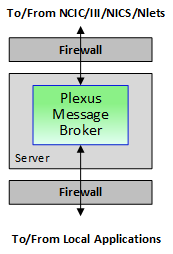Justice/Law Enforcement
Technical Summary
- Healthcare
- Emergency Services
- Justice/Law Enforcement
- Mgmt. Summary
- Technical Summary
- Unemployment Benefits
- Legacy Terminals
- Public Safety
 This Plexus Message Broker solution features the following technology: WebSphere® MQ; synchronous and asynchronous messaging; flow control; and complex routing. This solution’s site and Plexus Message Broker configurations touch on these features below.
This Plexus Message Broker solution features the following technology: WebSphere® MQ; synchronous and asynchronous messaging; flow control; and complex routing. This solution’s site and Plexus Message Broker configurations touch on these features below.
Site Configuration
As illustrated below, this site has a single physical server that contains a single instance of the Plexus Message Broker. The site maintains a hot standby of the physical server.
As with all Plexus Message Broker installations, adding physical servers, increasing Plexus Message Brokers instances per physical server, or transitioning to run the Plexus Message Broker in a virtual machine (VM) environment is only a matter of installation and configuration. No other Plexus Message Broker modifications are necessary. Resources are typically added for performance reasons, local redundancy reasons, or both.
At this particular site, the response time for request and responses is not hypercritical. Moreover, the IT procedure to hot swap the stand-by system is short enough to meet the business needs for response time. Hence, this very simple configuration is suitable.
Plexus Message Broker Configuration
As illustrated below, this Plexus Message Broker has sets of messages servers as well as individual messages servers to achieve the desired communications. There is an inbound message server and an outbound message server for Nlets; whereas for NCIC the same message server processes both inbound and outbound traffic. Then there are individual messages servers for NCIC unsolicited notification traffic, III metered traffic and NICS metered traffic. The latter two messages servers are the same type but with different configurations.
Plexus Message Server Functions
| Message Server | Function |
| Outbound Nlets | Removes MQ message from queue; unwraps message, opens a TCP session with Nlets using a proprietary TCP protocol, and sends the message to Nlets. The Inbound Nlets Message Server handles the response message that is returned on a separate TCP session and sent to Nlets via a proprietary TCP protocol. |
| Inbound Nlets | Receives message from Nlets over a proprietary TCP protocol, determines which application should receive the message, wraps the message in an MQ message, and inserts the MQ message in the appropriate application queue |
| Outbound & Inbound NCIC | Receives messages from local applications in the ToNCIC queue and sends the messages to NCIC via the NCICSync queue at NCIC. Response messages are received in the NCICResponse queue and then are unwrapped and inserted into the appropriate application queue. |
| Outbound III Meter | Sends ping (test) message to III on a periodic basis to determine if the III service is active. If III is active, a III message is removed from the ToIIIFlow queue and sent to III via the NCICSync queue. The response to this message is received in the NCICNotifiation Queue which is managed by the InboundNCICNotification Message Server. If III is not active, messages are queued in the ToIIIFlow queue until the III service becomes active. |
| Outbound NICS Meter | Similar to Outbound III Meter Message Server except for the messages being routed to NICS instead |
| Inbound NCIC Notifications | Removes message from NCICNotification queue, determines which application should receive the response, and deposits the message in that applications queue |


